#Stanisław Bagieński
Text
The Galician campaign of 1809
Today let me tell you a little bit about the Galician campaign of the Austro-Polish war of 1809, which proved to be a great success for the Duchy of Warsaw.
After the battle of Raszyn there happened the series of small battles, which prevented Austrians from crossing the Vistula, thus leaving the initiative on the right bank of the river firmly with the Poles. So, the Polish forces under Poniatowski’s command moved along Vistula to the South-East, to the lands Austria seized during the latest partition of Poland.
On the 14th of May the Polish Army entered Lublin:
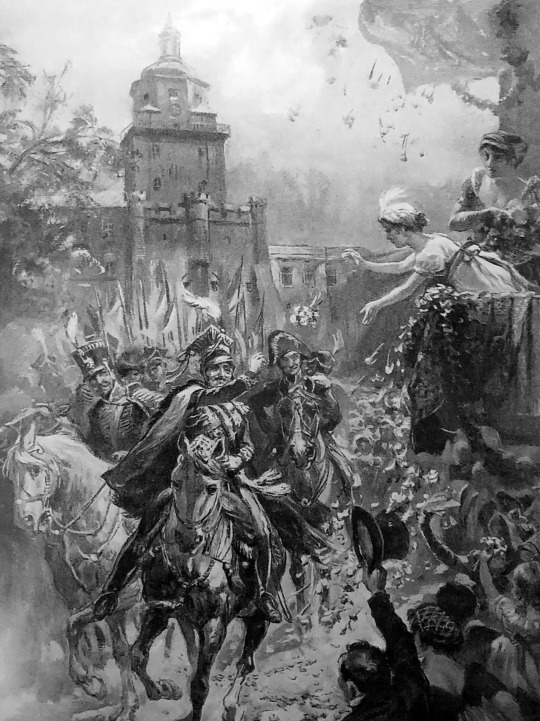
Konstanty Gorski, "Prince Józef Poniatowski enters conquered Lublin in 1809, showered with flowers by ladies"
As Kajetan Koźmian recalls in his memoirs, Poniatowski and his men were greeted with "joy and elation", and in the evening "... the city and the citizens gave a great ball <...> in the house in Korce. Prince Józef honored them with his presence starting the ball."
The next city on the way of the Polish Army was Sandomierz, and after a short siege it was taken on the 18th of May.

Siege of Sandomierz in 1809.

Michał Stachowicz, a scene from the battles in Galicia ("The Capture of Zamość")
Then there was Zamość, where the Polish trooped entered on the 20th of May.
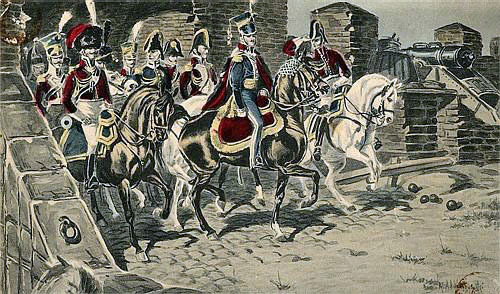
Siege of 1809, M. Adamczewski Entry of Prince Poniatowski to Zamość (postcard)
On the 27th of May the Polish advanced forces even reached the city of Lwów, but prince Józef wasn’t among them.
Meanwhile the Austrians under command Archduke Ferdinand realized the precariousness of their position in the center of Poland, and on the 1st of June left Warsaw for the south.
Poniatowski, for his part, decided not to engage with the Austrian, focusing instead on "liberating” as much Galician land as possible.

Prince Józef Poniatowski seeks information from local peasants in Galicia in 1809, a photo of Stanisław Bagieński's painting
On the 3rd June there appeared the third participant of the events - Russian forces crossed the Austrian border to Galicia as well. And though formally they were acting as Napoleon’s ally, as was prescribed in the Tilsit Treaty, their real goal was to prevent the Poles from taking too much of the Austrian-held territories.
So, to outwit the Russians prince Józef was taking Galician cities not in the name of the Duchy of Warsaw, but in the one of emperor of the Frenchmen. Like the proclamations were being made in the name of Napoleon, the eagles on the coats-of-arms replacing the Austrian ones were not Polish and French etc.
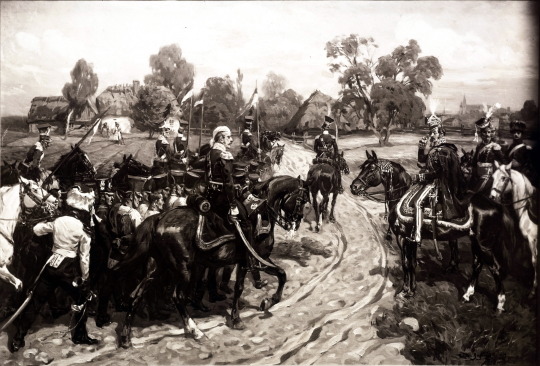
Lancers lead Austrian prisoners of war near Kraków in 1809, in front of Prince Józef Poniatowski, a photo of Stanisław Bagieński's painting
Then, in the outer theater of war on the 6th of July the French defeated the Austrians at the Battle of Wagram. And according Franco-Austrian truce signed five days later the land division was to take place along the line where the troops were at the time of receiving news of the truce, not at the time its signing.

The Austrian army leaves Wawel, a postcard based on the painting of Wojciech Kossak
And so began the race between Russians and Poles, to advance to as farther as possible.
In the middle of July both armies reached Kraków.

PRINCE JOSEPH'S ENTRY TO KRAKOW. A drawing by Jan Feliks Piwarski.
And there the clash of the interest took place.
Poniatowski approached the city from the side of St. Florian's Gate, but it turned out that the Austrians, wanting more comfortable terms of capitulation, had already let Russian troops into Kraków.
The Russians, namely the Cossacks of General Sievers, wanted to deny Poniatowski passage. But Prince Józef, as Dezydery Chłapowski recalls in his memoirs, "draw his broadsword and with together his staff galloped into the gate through the Cossacks". The Polish infantry followed its commander "in a double step <...> so that the Cossacks were pressed against the walls of the gate." Seeing this, Mariampol's hussar regiment, which was stationed at that time in the market square, make a decision to put up resistance and due to this, the whole Polish army was able to enter the city.

Michał Stachowicz, The entry of Prince Józef Poniatowski into Krakow on July 15, 1809
Then, as Ambroży Grabowski recalled, when prince Józef’s troops reached the market square, “in front of the church of St. Wojciech, the magistrate went out to meet the prince, to give him the keys of the city”.
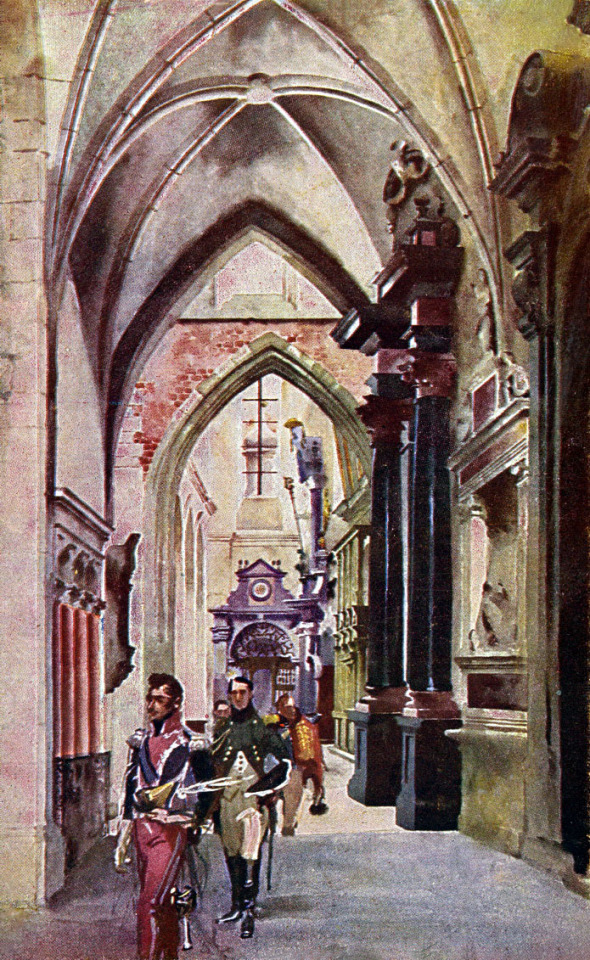
Józef Poniatowski in the Cathedral after Kraków was taken from the Austrians, an image by Stanisław Tondos and Wojciech Kossak
Most probably prince Józef visited the Wawel cathedral during his sojourn in Kraków that time. (In a small voice: little did he know that in 8 years he’ll be buried there...)
And after exactly a month since the Polish troops entered Kraków, there was a ball arranged in the Cloth-hall, the image depicting it I have already posted here.
#Poniatowski#Jozef Poniatowski#józef poniatowski#1809#Galicia#Lublin#Sandomierz#Zamość#Kraków#Austro-Polish War#Konstanty Gorski#Michał Stachowicz#Stanisław Bagieński#Wojciech Kossak#Feliks Piwarski#Kajetan Koźmian#Dezydery Chłapowski#ambroży grabowski
32 notes
·
View notes
Text
My Western, mostly American and Anglo-Saxon friends: Halloween
My Celtic friends: Samhain
Me, a Slav: DZIADY
But seriously, I really recommend you to read about Dziady (or the Forefathers’ Eve, as that’s how it is sometimes translated into English). It is traditionally celebrated in Belarus, Ukraine, Baltic countries, and some parts of Poland as well. Similarly to Celtic Samhain, it is also believed that during Dziady our ancestors come back to the world of the living. As the descendants, we are obligated to welcome them properly, commemorate them, and learn from whatever advice they may have for us. It's really cool, Adam Mickiewicz, the national poet of Poland, Lithuania and Belarus, even wrote a drama inspired by this feast!
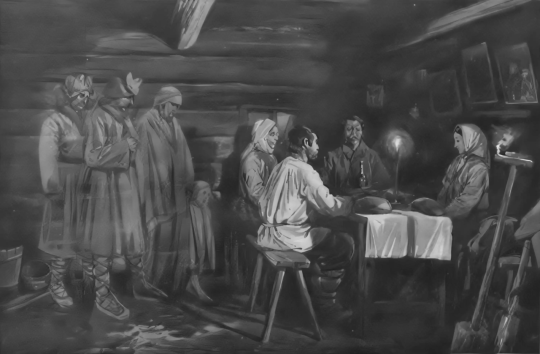
(“Dziady, pradziady, przyjdzcie do nas!” Depiction of dziady ritual in Belarus, Stanisław Bagieński. Source: Wikipedia)
More under this link:
#eastern Europe#eastern european#slavic countries#baltic countries#poland#belarus#ukraine#lithuania#latvia#estonia#halloween#samhain#dziady#the forefathers’ eve#slavic culture#dziady jesienne#ancestral cult#october 31st#november 1st
178 notes
·
View notes
Text
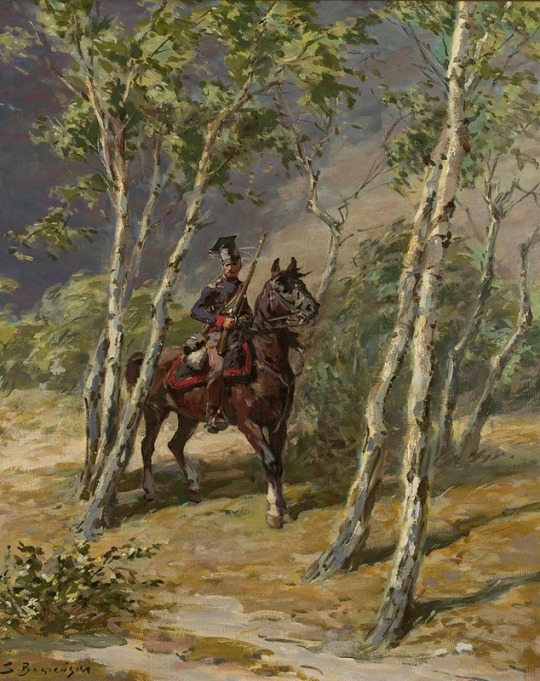
Uhlan on horseback
Stanisław Bagieński (Polish, 1876-1948)
#horse art#military#stanislaw bagienski#I was drawn immediately to the color of the sky#and I also like how you can see how windy it is
0 notes
Photo

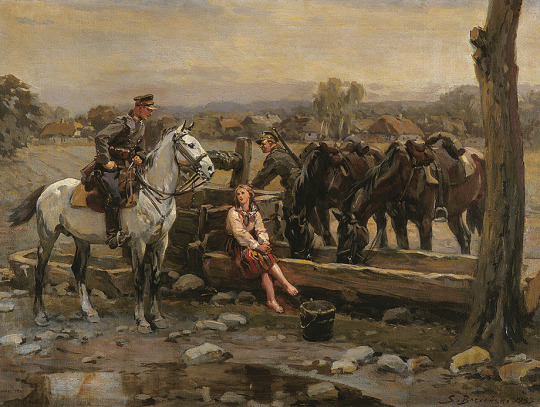
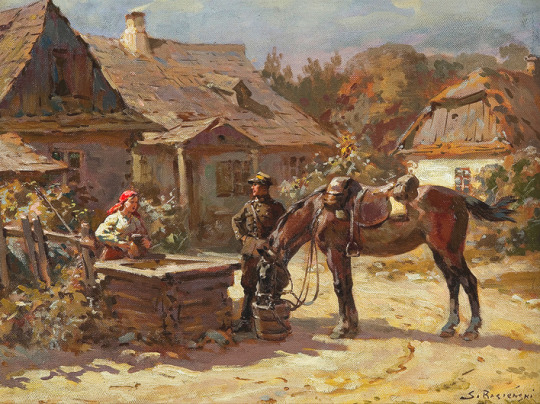
Stanisław Bagieński (Polish 1876 - 1948): selection of paintings depicting Polish Uhlans in rural scenery, c. 1920s/1930s [via Agra-art].
322 notes
·
View notes
Text
Napoleon by Stanisław Bagieński
Good evening to you, dear all, and let me show you again a couple of photos of lost Polish paintings. This time it will be works of Stanisław Bagieński.
The first one depict the Emperor Napoleon leading the Army:

And the second one is the emperor at the battlefield:

There a more photos of Bagieński’s works, if you are interested in you can find them here.
43 notes
·
View notes
Photo

“Woman in Folk Costume” by the Polish artist Stanisław Bagieński (1876-1948), watercolor on paper. Image via Desa.
68 notes
·
View notes